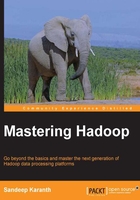
Chapter 2. Advanced MapReduce
MapReduce is a programming model for parallel and distributed processing of data. It consists of two steps: Map and Reduce. These steps are inspired from functional programming, a branch of computer science that deals with mathematical functions as computational units. Properties of functions such as immutability and statelessness are attractive for parallel and distributed processing. They provide a high degree of parallelism and fault tolerance at lower costs and semantic complexity.
In this chapter, we will look at advanced optimizations when running MapReduce jobs on Hadoop clusters. Every MapReduce job has input data and a Map task per split of this data. The Map task calls a map function repeatedly on every record, represented as a key-value pair. The map is a function that transforms data from one domain to another. The intermediate output records of each Map task are shuffled and sorted before transferring it downstream to the Reduce tasks. Intermediate data with the same keys go to the same Reduce task. The Reduce task calls the reduce function for a key and all its associated values. Outputs are then collected and stored.
The Map step has the greatest degree of parallelism. It is used to implement operations such as filtering, sorting, and transformations on data. The Reduce step is used to implement summarization operations on data. Hadoop also provides features such as DistributedCache as a side channel to distribute data and Counters to collect job-related global statistics. We will be looking at their utility in processing MapReduce jobs.
The advanced features and optimizations will be explained with the help of examples of code. Hadoop 2.2.0 will be used throughout this chapter. It is assumed that you have access to the Java development environment and a Hadoop cluster, either in your organization, the cloud, or as a standalone/pseudo-distributed mode installation on your personal computers. You need to have knowledge on how to compile Java programs and run Hadoop jobs to try out the examples.
In this chapter, we will look at the following topics:
- The different phases of a MapReduce job and the optimizations that can be applied at each phase. The input, Map, Shuffle/Sort, Reduce, and the output phases will be covered in depth with relevant examples.
- The application of useful Hadoop features such as DistributedCache and Counters.
- The types of data joins that can be achieved in a MapReduce job and the patterns to achieve them.